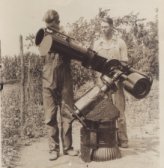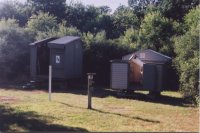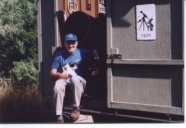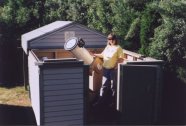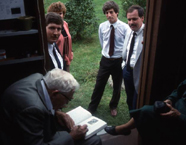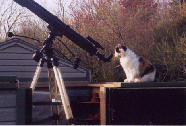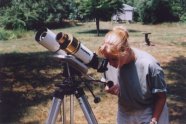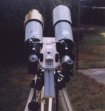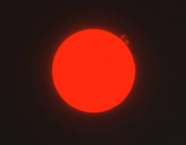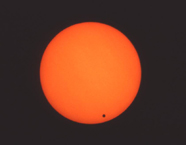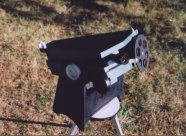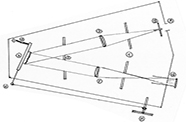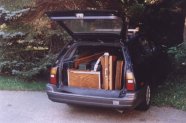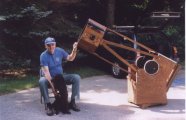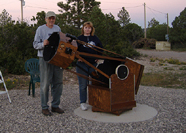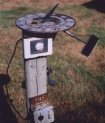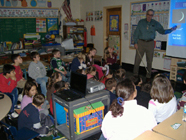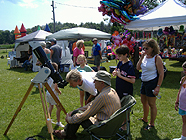Gerald P. Dyck
|
I got my start in astronomy eight years before I was born. In 1931 my father, Walter (on the left), and his cousin Paul Kuhlmann made a 7" reflector from scratch. This was before kits were commercially available. An article in Scientific American got them started. They ordered two blanks and an eyepiece, but made everything else from what they could find on their Kansas farm. The base was a stove; the RA and Dec shafts were two halves of a Model-T axle; the gears and drive motor came from a Victrola player; and the tube was a silage pipe. It was all very non-portable. By the time I was born only the tube assembly survived. Through this scope I got my first enhanced looks at the heavens. These views were the start of six decades of astronomical joy and adventure. I am grateful for the resourcefulness of my Dad and Uncle Paul.
Today our observing facility consists of two observatories and a variety of portable instruments. The main building is a merry-go-round observatory built in 1983 which houses a home-made 17.5" reflector, built a year earlier. This telescope won an award for mechanical design at Stellafane in 1983. The observatory is described in detail on page 297 in the September 1988 issue of Sky and Telescope. This is the instrument with which I make the bulk of my variable star observations for the AAVSO. The second building nearby is a roll-roof observatory which houses a home-made 10" reflector and a commercial 4" refractor, both of which are used for group observing sessions.
I am frequently accompanied by Sophie and Smudge. The replica of the Stellafane logo on the sliding door was painted by my wife Helga who is a keen astronomical observer, a frequent companion at the telescope and a strong supporter of my astronomical activities.
The most notable guest to visit our observatories was Clyde W. Tombaugh, discoverer of Pluto, who came to New England in 1986. Before giving a lecture at the Skyscrapers Club he was escorted around to visit members' observatories. He is seen here inscribing some gracious words into my logbook.
Sophie is a keen observer of all things around her, but rarely allows herself to be photographed in a pose not of her own choosing.
I used a variety of solar scopes before deciding upon the very practical and portable set-up of side-by-side 80mm refractors on an altaz mount. A spring serves as a counter-balance. With these twin scopes I make regular sunspot counts for the AAVSO and share the solar wonders with my students, friends and family. Pictured above is my daughter Laura.
Astrophotography is not an area in which I concentrate, but I have taken several solar photographs which please me. Two of these are of the twin solar prominences in January of 1999 and the much-awaited transit of Venus in May of 2004. I have contributed sunspot counts to the AAVSO Solar Division since 1998.
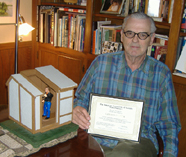 |
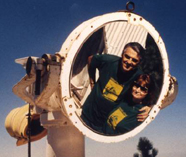 |
| Left: Reaching a personal milestone of 100,000 CV observations. Right: Helga and I are seen reflected in the coelostat of the Snow Solar Telescope at Mt. Wilson | |
I joined the AAVSO in 1978 and began observing Mira variables. I caught the spark four years later when I saw my first outburst of U Geminorum. This coincided with the construction of the merry-go-round observatory. At that point I determined that such a facility should not be used for casual observing alone. In 1982 I began a sustained effort to observe all the dwarf novae I could manage. In 1996, while at Mt. Wilson as an instructor in the CUREA hands-on astronomy program of Joe Snider of Oberlin, I taught variable-star astronomy and reached my personal milestone of 100,000 CV observations. Beside me is a 1/12 model of the merry-go-round observatory. I reached the milestone of 150,000 observations in 2005.
Another home-made instrument is my solar spectroscope. It was shown at the 1999 fall meeting of the AAVSO in Hyannis. It is made with two razor blades for a slit, a pair of surplus binocular objectives, a $6 grating, an elastic band for a tuner, and one commercial eyepiece. A filter wheel in front of the slit allows for greater definition in various portions of the spectrum. This simple instrument shows several hundred absorption lines and has been a very useful teaching tool. It won a special exhibit award at Stellafane in 1982.
|
|||||
|
|
||||
A look under the lid shows the workings. Light enters the slit at upper right, then passes through a baffle, to a collimating lens focused on the tilt-mounted grating at far left. The reflected spectrum travels through a second collimating lens and a second baffle to the eyepiece. Tuning is achieved by turning the black wheel below the eyepiece, thus controling the tilt of the grating. All elements of the spectroscope were first mounted individually like chess pieces. I moved them to and fro until everything worked, then traced the pattern onto a "floor plan" and built a box around everything. Anyone interested in receiving a free drawing may do so by sending me a self-addressed stamped envelope.
My 17.5" Dobsonian was built as one solid unit. This works well in a permanent observatory. In 1995 I built a second tube assembly for the same optics, this time with "some assembly required." The rocker box is collapsible, the octagonal head piece fits into the tail piece, and struts remain as four triangular units for quick assembly. Assembly takes about twenty minutes and collimation another ten. Smudge's assistance makes the work more enjoyable, but not significantly shorter in duration.
In the summer of 2003 Helga and I took the travel scope to New Mexico Skies guest observatories for five nights of superb viewing of variable stars and deep-sky objects.
|
Rounding out my astronomical equipment is a partially viable sun dial. The gnomon and dial face work as they should; the remaining features are for the benefit of my fun-loving or gullible friends. Below the face is the wake alarm. Below that, the crank for winding it on cloudy days. Furthest down is the energy saver switch which I turn off during vacations. The rear-view mirror is for night use only. |
Since my retirement from daily music teaching in the Dartmouth Public Schools I have developed a program of astronomy instruction for elementary schools called "Have Scope — Will Travel." PowerPoint slide shows on solar, lunar, planetary and stellar astronomy are geared for the classroom and precede observing parties for students and their parents. I also take my 5-inch refractor to where the public are in the good tradition of sidewalk astronomy.
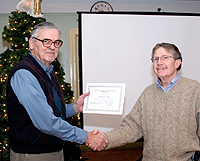 |
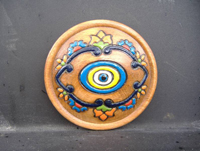 |
| Gerry Dyck receives the 150,000 Visual Observer Award presented by AAVSO council member David Hurdis at the Amateur Astronomical Society of Rhode Island meeting | Anti-Evil Eye, "Nazar Boncugu" |
Among my most prized astro-possessions is a 5-inch diameter carving which adorns and protects our observatories. It is the Turkish Anti-Evil Eye given to us by Janet Mattei when she and Mike visited us in 1990. I trust it and the spirit of the giver to bless our astronomical endeavors far into the future.
Respectfully submitted,
Gerald P. Dyck 29 Pleasant Street Assonet MA 02702 508-644-2419


